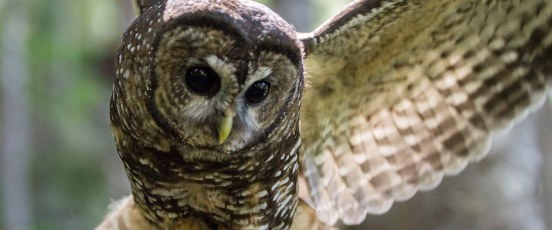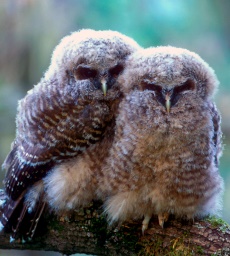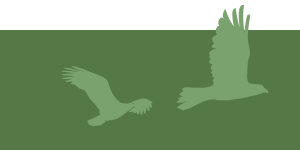
CALIFORNIA SPOTTED OWLS AND WILDFIRE

Wildfire is a paramount issue for Sierra Nevada land managers. Historical logging and fire exclusion has likely contributed to declines in old-forest dependent species, including California Spotted Owl. More recently, concern has grown that high-severity, stand-replacing fires, which appear to have become more common, may constitute another threat to the species.
Research is needed to better understand how Spotted Owls respond to wildfire so that post-fire landscapes can be managed to give the species the best chance of persisting. In past work, we radio-tracked adult owls in territories that were burned by a large wildfire. The owls continued to occupy partially burned territories several years after fire and preferentially forage in severely burned patches. We also assessed daytime roosts during the non-breeding season to study how ranges and habitat use by birds with partially burned territories shifted during the winter.
A third component of this project was examining whether breeding-season diet and home-range size of California Spotted Owls differed between our burned study site and other unburned study sites in the Sierra Nevada. We collected and analyzed regurgitated pellets at roosting locations in our burned site to quantify the diet of owls whose territories were affected by forest fire. Finally, we also conducted an analysis of data from across large swaths of the Sierra Nevada to assess patterns in Spotted Owl occupancy after fire.
More recently we have teamed up with Yosemite National Park biologists to study occupancy patterns in recently burned forests.
For more information about IBP’s work with Spotted Owls and post-fire landscapes, please contact Rodney Siegel.
Photo Credits: Top of Page, National Park Service; Right Column, U.S. Fish and Wildlife Service
NORTHERN SPOTTED OWLS
In addition to studying the ecology of California Spotted Owl, IBP has conducted conservation-relevant research on Northern Spotted Owl.
We partnered with personnel at North Cascades National Park in Washington to survey the dwindling population of the species in the Park, including at remote wilderness areas many days' hike from the nearest road. We also assisted the Park with habitat suitability modeling and developing management plans for nesting areas.

SELECTED PUBLICATIONS
Peer-reviewed Publications
Stillman, A.N., R.L. Wilkerson, D.R. Kaschube, R.B. Siegel, S.C. Sawyer, and M.W. Tingley. 2023. Incorporating pyrodiversity into wildlife habitat assessments for rapid post-fire management: a woodpecker case study. Ecological Applications 2023:e2853. PDF
Siegel, R. and R. Wilkerson. 2022. A giant loss: losing sequoias could be a blow to Sierra Nevada Birds. The Wildlife Professional 16:54-55. PDF
Loverin, J.K., A.N. Stillman, R.B. Siegel, R.L. Wilkerson, M. Johnson, and M.W. Tingley. 2021. Nestling provisioning behavior of Black-backed Woodpeckers in post-fire forest. The Journal of Field Ornithology 92:273-283. PDF
Stillman, A.N., T.J. Lorenz, R.B. Siegel, R.L. Wilkerson, M. Johnson, and M.W. Tingley. 2021. Conditional natal dispersal provides a mechanism for populations tracking resource pulses after fire. Behavioral Ecology 2021:1-10. PDF
Schofield, L.N., S.A. Eyes, R.B. Siegel, and S.L. Stock. 2020. Habitat selection by spotted owls after a megafire in Yosemite National Park. Forest Ecology and Management 478:118511. PDF
Blakey, R.V., R.B. Siegel, E.B. Webb, C.P. Dillingham, R.L. Bauer, M. Johnson, and D.C. Kesler. 2019. Space use, forays, and habitat selection by California Spotted Owls (Strix occidentalis occidentalis) during the breeding season: new insights from high resolution GPS tracking. Forest Ecology and Management 432:912-922. For a copy of this publication, please contact Rodney Siegel.
Bond, M.L., D.E. Lee, R.B. Siegel, and M.W. Tingley. 2013. Diet and home range size of California Spotted Owls in a burned forest. Western Birds 44:114-126. PDF
Lee, D.E., M.L. Bond, and R.B. Siegel. 2012. Dynamics of breeding-season site occupancy of the California Spotted Owl in burned forests. The Condor 114:792-802. PDF
Bond, M.L. D.E. Lee, R.B. Siegel, and J.P. Ward. 2010. Habitat use and selection by California Spotted Owls in a post-fire landscape. The Journal of Wildlife Management 73:1116-1124. PDF
Bond, M.L., D.E. Lee, and R.B. Siegel. 2010. Winter movements by California Spotted Owls in a burned landscape. Western Birds 41:174-180. PDF
Other Publications and Reports
Siegel, R.B., M.W. Tingley, and R.L. Wilkerson. 2022. Black-backed Woodpecker MIS surveys on Sierra Nevada national forests: 2021 annual report. The Institute for Bird Populations, Petaluma, CA. PDF
Schofield, L.N., R.B. Siegel, J.X. Wu, and R.L. Wilkerson. 2015. Avian monitoring in the King Fire: surveying Spotted Owls and Northern Goshawks during the 2015 breeding season. Report to the US Forest Service, Eldorado National Forest. The Institute for Bird Populations, Point Reyes Station, CA.
Siegel R.B., R.C. Kuntz II, R.L. Wilkerson, K.D. Kuhlman, and M.D. Toshack. 2012. Surveying for Spotted Owls in the Upper Skagit watershed of North Cascades National Park Complex, 2009-2010. Natural Resource Technical Report. NPS/NOCA/NRTR—2012/597. National Park Service. Fort Collins, CO. Published Report-2186188. PDF
Siegel, R.B, R.C. Kuntz II, R.L. Wilkerson, and K.D. Kuhlman. 2010. Surveying for Spotted Owls in the northeastern portion of North Cascades National Park Service Complex, 2009-2010: report for the 2009 field season. Natural Resource Technical Report NPS/NCCN/NRTR/2010/334. National Park Service, Fort Collins, CO. PDF
Siegel, R.B., K.E. Jablonski, M.N. Scholer, R.C. Kuntz II, and R.L. Wilkerson. 2008. Surveying Spotted Owls on the east slope of North Cascades National Park Service Complex: report for the 2007 and 2008 field seasons. Report to North Cascades National Park Service Complex. Natural Resource Technical Report NPS/NCCN/NRTR 2008/114. National Park Service, Fort Collins, CO. PDF
Wilkerson, R.L., and R.B. Siegel. 2007. Interpreting the Northwest Forest Plan’s Northern Spotted Owl habitat suitability model for use in North Cascades National Park. Report to North Cascades National Park Service Complex. The Institute for Bird Populations, Point Reyes Station, CA.









